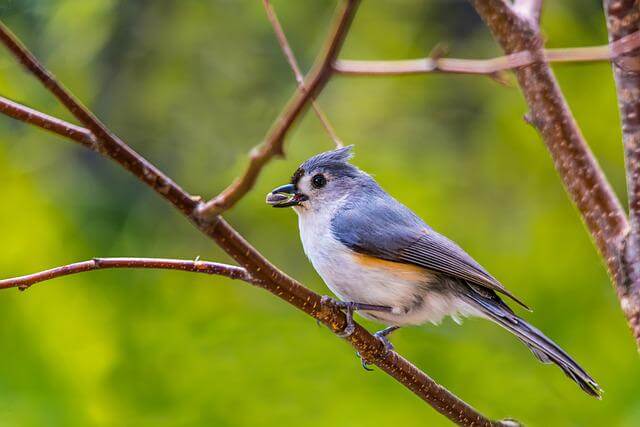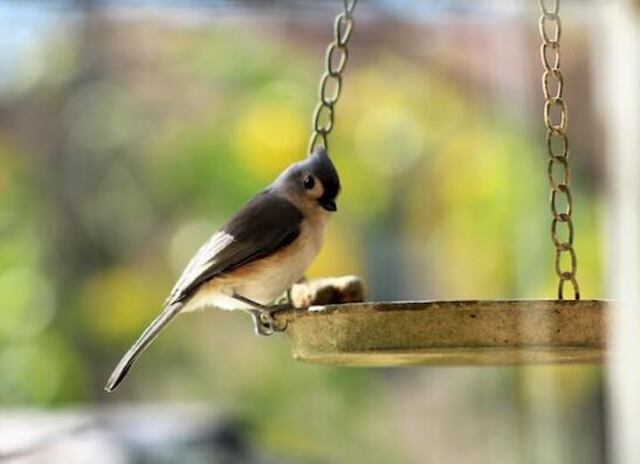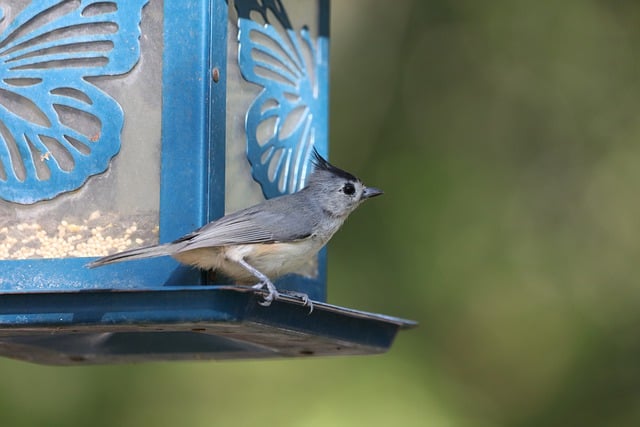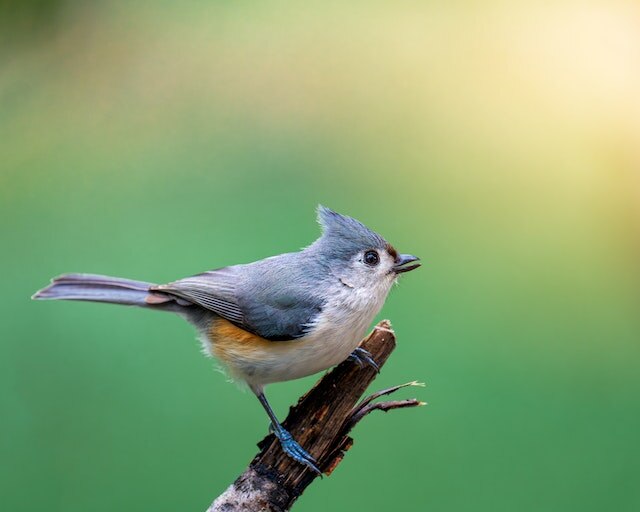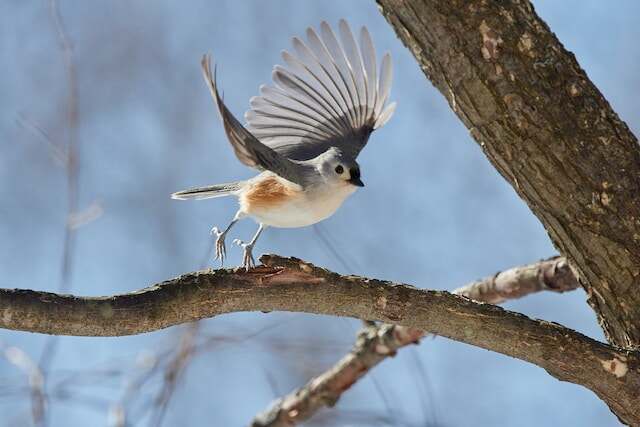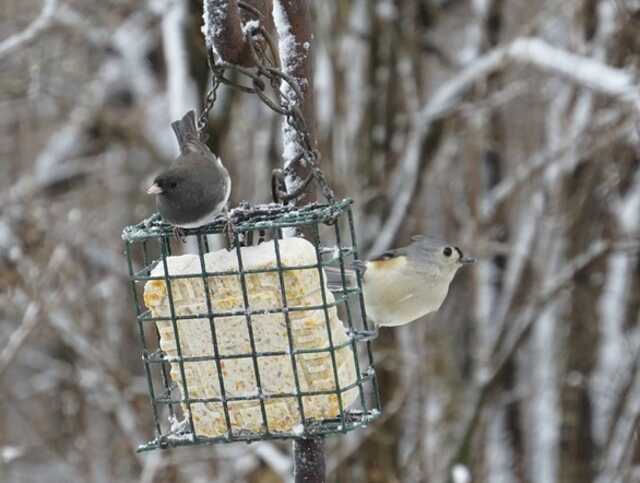Attracting tufted titmice to your yard can be a rewarding and enjoyable experience. These birds are known for their distinctive crested heads and friendly personalities, making them a favorite among birdwatchers.
However, attracting tufted titmice to your yard requires some knowledge and effort. In this article, we will provide you with tips and guidance on how to create an inviting environment for these beautiful birds.
Table of Contents
- 1 Key Takeaways:
- 2 How to Attract Tufted Titmouse to my Yard
- 3 Understanding Tufted Titmouse Habitat Preferences
- 4 Providing Food and Feeders to Attract Tufted Titmice
- 5 Incorporating Natural Landscaping for Tufted Titmouse
- 6 Designing a Titmouse-Friendly Yard
- 7 Attracting Tufted Titmouse with Bird Baths and Water Sources
- 8 Nesting Requirements for Tufted Titmouse
- 9 Maintaining a Welcoming Environment
- 10 Monitoring Tufted Titmouse Activity
- 11 Troubleshooting and Problem-Solving
- 12 Enjoying the Presence of Tufted Titmouse
- 13 Conclusion
- 14 FAQs: How to Attract Tufted Titmouse to my Yard?
- 14.1 How can I attract tufted titmice to my yard?
- 14.2 What types of food should I offer to attract tufted titmice?
- 14.3 How can I incorporate natural landscaping for tufted titmice?
- 14.4 What should I consider when designing a titmouse-friendly yard?
- 14.5 How can I attract tufted titmice with bird baths and water sources?
- 14.6 What are the nesting requirements for tufted titmice?
- 14.7 How can I maintain a welcoming environment for tufted titmice?
- 14.8 How can I monitor tufted titmouse activity in my yard?
- 14.9 How can I troubleshoot common issues when attracting tufted titmice?
- 14.10 What are the rewards of attracting tufted titmice to my yard?
- 15 Author
Key Takeaways:
- Understanding tufted titmouse habitat preferences is crucial in replicating their natural environment in your yard.
- Providing food and feeders that attract tufted titmice, such as sunflower seeds and suet, can encourage their presence.
- Designing a titmouse-friendly yard and incorporating natural landscaping, bird baths, and nesting boxes can create a welcoming environment for tufted titmice.
- Maintaining a clean and safe environment and monitoring their activity can ensure their continued presence in your yard.
- Successfully attracting tufted titmice to your yard can enhance your connection with nature and provide a sense of accomplishment.
| Attribute | Information |
|---|---|
| Identification | Small-sized bird with gray crest on head, gray upper parts, rust-colored accents under wings, grayish-white underbelly, black patch above bill. |
| Length | 5.1-6.4 in (13-16.5 cm) |
| Weight | 0.6-0.95 oz (17-27 g) |
| Wingspan | 7.9-10.4 in (20-26.5 cm) |
| Habitat Range | Throughout the United States |
| Preferred Habitat | Woodlands, forested areas, backyards, parks |
| Habitat Characteristics | Wooded areas with small trees and bushes |
How to Attract Tufted Titmouse to my Yard
Attracting Tufted Titmice to your yard is easy with these tips. Provide a variety of food sources, including sunflower seeds, peanuts, and suet. Place bird feeders and nesting boxes in a quiet, sheltered spot away from predators.
Plant native trees and shrubs, such as oak and hickory, to provide nesting sites and shelter. Finally, provide a source of water for drinking and bathing. With these simple steps, you can create a welcoming environment for Tufted Titmice and enjoy their beautiful songs and antics in your yard.
Understanding Tufted Titmouse Habitat Preferences
Tufted titmice are native to deciduous forests of eastern North America, where they inhabit a variety of forested habitats, including oak-hickory, maple-beech, and mixed deciduous-coniferous forests. They are cavity-nesting birds and require suitable nesting sites in which to raise their young.
If you want to attract tufted titmice to your yard, it’s important to create an inviting environment that replicates their natural habitat preferences. A few key elements to consider include:
| Key Elements | Description |
|---|---|
| Trees and Shrubs | Planting a variety of native trees and shrubs provides shelter and nesting sites for tufted titmice. Oaks, hickories, maples, and beeches are all great options. |
| Nesting Sites | Provide nesting boxes or natural cavities, such as dead trees or limbs, to give titmice a safe and secure place to raise their young. |
| Food Sources | Offering a reliable food source, such as sunflower seeds, suet, or mealworms, is essential for attracting and keeping tufted titmice in your yard. |
| Water | Be sure to provide a clean and reliable source of water, such as a bird bath or fountain, for drinking and bathing. |
By incorporating these elements into your yard, you can create a welcoming environment for tufted titmice and potentially attract them to your feeders and nesting boxes for years to come.
Providing Food and Feeders to Attract Tufted Titmice
Feeding tufted titmice is an excellent way to attract them to your yard. These birds love sunflower seeds, peanuts, and suet, so consider investing in a tube feeder or hopper feeder that can accommodate these food types.
Mealworms and a jar of peanut butter placed on a peanut butter feeder are also great options, particularly during nesting season, when these birds need a high-protein diet to feed their young.
During winter, I would recommend using suet feeders with a peanut butter suet. The product links mentioned above will take you to Amazon.
Place feeders close to trees and shrubs, as tufted titmice prefer to feed in areas with natural cover. Keep feeders clean and filled with fresh food to maintain the birds’ interest and health.
It’s also a good idea to keep multiple feeders spread out in different areas of your yard to prevent overcrowding and competition among birds.
Titmice are also known to cache food in small holes in trees or under bark. Providing a bark butter feeder or logs with holes drilled in them can give tufted titmice the opportunity to indulge in this natural instinct.
Keep in mind that titmice are shy birds and may be intimidated by larger or more aggressive species. Consider using smaller feeders to provide a safe space for these birds to feed undisturbed.
Finally, always use appropriate feeder placement in your yard, away from windows to prevent collisions, and at an accessible height for refilling and cleaning.
Incorporating Natural Landscaping for Tufted Titmouse
Tufted titmice are natural dwellers of wooded areas, where they can find plenty of nesting and foraging opportunities. To attract these birds to your yard, it’s essential to replicate their natural environment and provide suitable nesting conditions. Here are some tips on how to create a titmouse-friendly landscape:
- Plant native trees and shrubs: Tufted titmice prefer deciduous trees such as oaks, maples, and hickories that offer sufficient cavities for nesting and roosting. Adding small to medium-sized shrubs such as viburnums, blueberries, and serviceberries can also help to attract these birds. Avoid using invasive species that do not provide adequate resources for wildlife.
- Provide dead trees and natural cavities: Tufted titmice rely on natural tree cavities for nesting and breeding. Leaving dead trees or snags in your yard can provide a suitable nesting site for these birds. You can also install nesting boxes specifically designed for tufted titmice, ensuring they are placed in a quiet and protected area.
- Create a diverse habitat: Tufted titmice thrive in areas with a variety of vegetation structures. Incorporate a mix of trees, shrubs, and ground covers to create a diverse environment that can provide shelter and food sources throughout the year.
- Minimize pesticide and fertilizer use: Pesticides and fertilizers can harm tufted titmice and their food sources. Instead, use natural alternatives or reduce their use to a minimum.
By incorporating natural landscaping techniques in your yard, you can create a welcoming and productive environment for tufted titmice and other bird species.
Designing a Titmouse-Friendly Yard
To attract tufted titmice to your yard, you must create a welcoming environment that caters to their needs. Designing a titmouse-friendly yard involves incorporating features that make your outdoor space safe, comfortable, and engaging for these beautiful birds.
Incorporate Birdhouses and Perches
Tufted titmice enjoy perching on tree branches and birdhouses, and these features can be easily incorporated into your yard design. Place birdhouses in strategic locations, such as near a food source or in a secluded area for nesting. Ensure that the birdhouses have small entrance holes and are made of durable materials.
Perches are another essential feature of a titmouse-friendly yard. These can be made by attaching branches to a tree or building a wooden perch. Place perches near birdhouses and food sources to create an inviting environment for these birds to perch and watch their surroundings.
Create a Safe and Predator-free Environment
Tufted titmice are vulnerable to predators such as cats, snakes, and birds of prey. To keep them safe, you must create a predator-free environment. Avoid using pesticides and chemicals that could harm these birds. Keep your yard clean and tidy by removing any potential hiding spots for predators.
You can also install predator deterrents such as netting around your bird feeders or adding a motion-activated sprinkler system to scare off predators.
Add a Birdbath and Water Source
Tufted titmice require a reliable source of water for drinking and cleaning their feathers. Adding a birdbath or water source to your yard is an excellent way to attract these birds.
Choose a shallow birdbath and place it in a shady area to prevent the water from becoming too hot. Clean the birdbath regularly to ensure a fresh supply of water.
You can also add a fountain or shallow dish with a continuous supply of water to create a more inviting environment for these birds.
Provide Shelter and Nesting Opportunities
Tufted titmice require shelter and nesting opportunities to survive and thrive. Incorporate natural landscaping features such as shrubs, bushes, and trees into your yard to create a diverse habitat. Plant native species to attract insects and other prey that titmice feed on.
You can also install nesting boxes or provide natural cavities in trees for titmice to build their nests. Ensure that the nesting boxes are placed in a secluded area away from predators and have a small entrance hole to prevent larger birds from entering.
By designing a titmouse-friendly yard, you can attract these beautiful birds and enhance your connection with nature.
Attracting Tufted Titmouse with Bird Baths and Water Sources
Providing water sources in your yard is essential for attracting tufted titmice. These birds require a reliable water supply for drinking and bathing, and incorporating bird baths or fountains in your yard is an effective way to meet their needs. You can find a top-notch birdbath just like this one, available on Amazon at an incredible value.
When choosing a bird bath, consider the size and depth of the basin. Tufted titmice prefer shallow water sources, so opt for a bath that is no more than two inches deep. The bath should also have a rough texture or a textured bottom to provide a secure grip for the birds.
When placing the bird bath, consider the safety and visibility of the birds. Position it near trees or shrubs to provide cover and a clear view of any potential predators. Avoid placing the bird bath too close to feeders, as fallen seeds can contaminate the water.
Regular maintenance is crucial for keeping bird baths clean and safe for birds. Change the water frequently, especially during hot weather or when algae growth is present. Scrub the basin with a brush and mild soap, and rinse thoroughly before refilling.
Incorporating a bird bath or water feature in your yard not only attracts tufted titmice but also provides a vital resource for other bird species. By providing fresh, clean water, you can create a thriving ecosystem that benefits a variety of wildlife.
Nesting Requirements for Tufted Titmouse
Tufted titmice are cavity nesters, meaning they prefer to nest in natural holes in trees or wooden nest boxes. These birds typically breed from April to July.
Ready to welcome these charming birds to your yard? Consider providing them with the perfect nesting spot they love – the Nature’s Way Nest Box. It’s designed to cater to their cavity nesting preference and is now available on Amazon at a very affordable price.
Here are some tips for creating suitable nesting opportunities for tufted titmice:
| Nesting Boxes | Natural Cavities |
|---|---|
| Mount a nest box with a 1.25-inch entrance hole, 6 to 10 feet above the ground. Place a layer of wood shavings or sawdust in the box to mimic natural nesting material. | Leave standing dead trees or dead branches in your yard, as these provide natural cavities for tufted titmice to nest in. |
It’s important to protect nesting sites from predators such as cats and squirrels. You can do this by placing baffles or netting around the nesting sites.
Once tufted titmice have established a nesting site in your yard, it’s important not to disturb them. Avoid pruning trees or cleaning gutters near the nesting site while the birds are present.
By providing suitable nesting opportunities, you can encourage tufted titmice to breed in your yard and continue to visit year after year.
Maintaining a Welcoming Environment
Once you have successfully attracted tufted titmice to your yard, it’s important to maintain a welcoming environment to encourage them to stay and thrive. Here are some tips to help you create a safe and inviting space for these beautiful birds:
Regular Cleaning
Keep your feeders and bird baths clean and well-maintained to prevent the spread of disease. Scrub them with hot soapy water at least once a month, and rinse thoroughly. Replace spoiled or moldy food promptly, and keep the feeding area tidy to discourage pests and predators.
Fresh Food and Water
Make sure your feeders and bird baths have a constant supply of fresh food and water. Check them regularly and refill as needed, especially during the hot summer months when water can evaporate quickly. Clean and refill your bird baths at least once a week to prevent the accumulation of algae or mosquitoes.
Safety and Protection
Ensure that your yard is a safe and predator-free environment by trimming back bushes and trees where predators might hide. Provide plenty of perches and hiding spots for birds to escape from predators, and avoid using pesticides or other harmful chemicals in your yard.
By following these tips, you can create a welcoming and safe environment for tufted titmice and other backyard birds. Enjoy the beauty of these feathered friends and the joy they bring to your outdoor space.
Monitoring Tufted Titmouse Activity
To ensure that your yard continues to provide a welcoming environment for tufted titmice, it’s important to monitor their activity. By observing their behavior and feeding habits, you can make adjustments to your yard to better accommodate their needs.
One way to monitor titmouse activity is to keep a birding journal. Record the dates and times when you see the birds in your yard, as well as their feeding and nesting behaviors. This can help you identify patterns and adjust your yard accordingly.
It’s also important to observe the interactions between tufted titmice and other birds in your yard. If you notice any aggressive behavior towards the titmice, it may be necessary to adjust the location or types of feeders in your yard to reduce competition.
Additionally, keep an eye out for any changes in tufted titmouse behavior. If there is a sudden decrease in their presence or activity, it may indicate a problem with the food or water sources in your yard.
By monitoring tufted titmouse activity in your yard, you can make sure that they continue to feel welcome and comfortable in your outdoor space. With a little observation and adjustment, you can create a habitat that supports these beautiful birds and enhances your connection with nature.
Troubleshooting and Problem-Solving
Attracting tufted titmice to your yard can be a rewarding experience, but it doesn’t always come without obstacles. Here are some common issues and solutions to help you troubleshoot any problems that might arise.
Problem: Squirrels raiding your bird feeders
Solution: Squirrels can be a pesky problem when it comes to bird feeders. To deter them, consider investing in squirrel-proof feeders or adding a squirrel baffle to your existing feeder. You can also try placing hot pepper flakes or other squirrel repellents around the feeder.
Problem: Predators targeting your tufted titmice
Solution: To protect your tufted titmice from predators such as cats or hawks, consider creating a safe environment around your yard. Ensure there are plenty of hiding spots and shelter options, such as dense shrubs or nesting boxes. You can also add extra perches or birdhouses to give the birds more options for escape.
Problem: Aggressive bird behavior
Solution: Sometimes, certain birds can become territorial and aggressive towards tufted titmice. To minimize this behavior, try adding multiple feeders and water sources throughout your yard. This can help distribute the birds and reduce competition. If necessary, you can also try temporarily removing the aggressive bird from your yard to give the titmice a chance to feed without disturbance.
Problem: Lack of tufted titmouse activity
Solution: If you’re not seeing any tufted titmice in your yard, it could be due to a lack of appropriate habitat or food sources. Double-check that you have plenty of natural landscaping, such as trees and shrubs, as well as a variety of feeder options with the birds’ preferred food. Consider adding a nesting box or creating a larger water source to further entice the birds.
By addressing these common issues, you can better create a welcoming environment for tufted titmice and increase your chances of enjoying their presence in your yard.
Enjoying the Presence of Tufted Titmouse
Watching a tufted titmouse in your yard is a true delight. These birds are known for their playful behavior and can often be seen flitting about, calling to one another, and snatching insects from the air.
If you want to truly appreciate the presence of tufted titmice, take some time to observe their behavior and feeding habits. You may notice that they prefer to feed at sunrise and sunset, or that they are particularly fond of sunflower seeds and suet.
Creating an inviting environment for tufted titmice in your yard is a rewarding experience. By providing food, water, shelter, and nesting sites, you can attract these beautiful birds and enjoy their presence year-round.
Take some time to explore the natural beauty of your yard and observe the behavior of the birds around you. Whether you are an avid birdwatcher or simply enjoy the company of feathered friends, creating a welcoming environment for tufted titmice is a wonderful way to connect with nature.
Conclusion
Congratulations! You are now equipped with all the tips and tricks necessary to attract tufted titmice to your yard. Remember to replicate their natural habitat preferences, provide suitable food and feeders, incorporate natural landscaping, design a titmouse-friendly yard, provide water sources, create nesting opportunities, maintain a welcoming environment, monitor their activity, and troubleshoot any problems that arise.
By following these guidelines, you’ll be able to create a thriving environment for tufted titmice and enjoy their beautiful presence in your yard. Don’t forget to keep a birding journal and observe their behavior and feeding habits. With time, you’ll be able to develop a deeper connection with these charming birds and appreciate the wonders of nature right outside your window.
Thank you for taking the time to read this article and learn how to attract tufted titmice to your yard. With a little effort and patience, you’ll be rewarded with the joy of birdwatching and the satisfaction of providing a safe haven for our feathered friends.
FAQs: How to Attract Tufted Titmouse to my Yard?
How can I attract tufted titmice to my yard?
To attract tufted titmice to your yard, you can provide them with a suitable habitat that includes trees, shrubs, and nesting sites. Additionally, offering the right types of food and feeders, incorporating natural landscaping, and creating a safe environment will help attract these beautiful birds.
What types of food should I offer to attract tufted titmice?
Tufted titmice prefer sunflower seeds, suet, and mealworms. Including these foods in your feeders will increase the chances of attracting these birds to your yard.
How can I incorporate natural landscaping for tufted titmice?
To incorporate natural landscaping for tufted titmice, you can plant native plants, provide shelter and nesting opportunities, and create a diverse environment with a variety of plants.
What should I consider when designing a titmouse-friendly yard?
When designing a titmouse-friendly yard, it’s important to include birdhouses, bird baths, and perches. Creating a safe and predator-free environment is also crucial.
How can I attract tufted titmice with bird baths and water sources?
To attract tufted titmice with bird baths and water sources, you can incorporate shallow dishes, fountains, or bird baths in your yard. Proper placement and regular maintenance are essential for ensuring a reliable water supply.
What are the nesting requirements for tufted titmice?
Tufted titmice require suitable nesting opportunities such as nesting boxes and natural cavities. Protecting nesting sites is crucial for their successful breeding.
How can I maintain a welcoming environment for tufted titmice?
To maintain a welcoming environment for tufted titmice, it’s important to regularly clean feeders and birdbaths, maintain your yard, and provide fresh food and water sources.
How can I monitor tufted titmouse activity in my yard?
A: You can monitor tufted titmouse activity in your yard by using observation techniques, keeping a birding journal, and learning more about their behavior and feeding patterns.
How can I troubleshoot common issues when attracting tufted titmice?
Common issues when attracting tufted titmice include dealing with squirrels, predators, or aggressive bird behavior. Troubleshooting tips and solutions can help address these problems.
What are the rewards of attracting tufted titmice to my yard?
Successfully attracting tufted titmice to your yard brings the joy of birdwatching, the beauty of these birds, and a stronger connection with nature.



